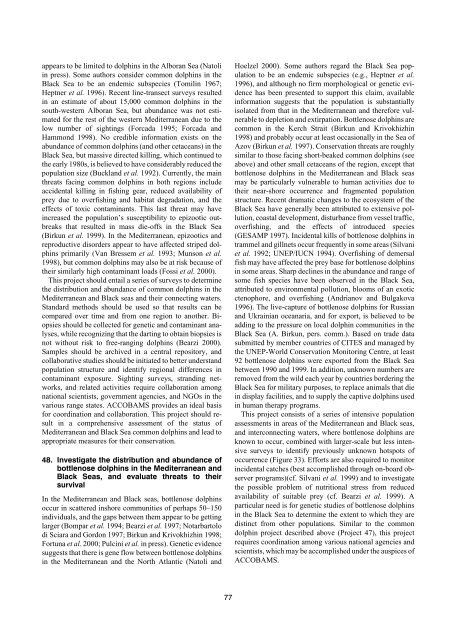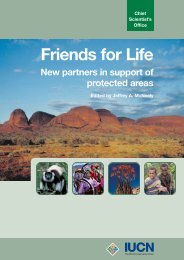Dolphins, Whales and Porpoises: 2002-2010 Conservation - IUCN
Dolphins, Whales and Porpoises: 2002-2010 Conservation - IUCN
Dolphins, Whales and Porpoises: 2002-2010 Conservation - IUCN
You also want an ePaper? Increase the reach of your titles
YUMPU automatically turns print PDFs into web optimized ePapers that Google loves.
appears to be limited to dolphins in the Alboran Sea (Natoli<br />
in press). Some authors consider common dolphins in the<br />
Black Sea to be an endemic subspecies (Tomilin 1967;<br />
Heptner et al. 1996). Recent line-transect surveys resulted<br />
in an estimate of about 15,000 common dolphins in the<br />
south-western Alboran Sea, but abundance was not estimated<br />
for the rest of the western Mediterranean due to the<br />
low number of sightings (Forcada 1995; Forcada <strong>and</strong><br />
Hammond 1998). No credible information exists on the<br />
abundance of common dolphins (<strong>and</strong> other cetaceans) in the<br />
Black Sea, but massive directed killing, which continued to<br />
the early 1980s, is believed to have considerably reduced the<br />
population size (Buckl<strong>and</strong> et al. 1992). Currently, the main<br />
threats facing common dolphins in both regions include<br />
accidental killing in fishing gear, reduced availability of<br />
prey due to overfishing <strong>and</strong> habitat degradation, <strong>and</strong> the<br />
effects of toxic contaminants. This last threat may have<br />
increased the population’s susceptibility to epizootic outbreaks<br />
that resulted in mass die-offs in the Black Sea<br />
(Birkun et al. 1999). In the Mediterranean, epizootics <strong>and</strong><br />
reproductive disorders appear to have affected striped dolphins<br />
primarily (Van Bressem et al. 1993; Munson et al.<br />
1998), but common dolphins may also be at risk because of<br />
their similarly high contaminant loads (Fossi et al. 2000).<br />
This project should entail a series of surveys to determine<br />
the distribution <strong>and</strong> abundance of common dolphins in the<br />
Mediterranean <strong>and</strong> Black seas <strong>and</strong> their connecting waters.<br />
St<strong>and</strong>ard methods should be used so that results can be<br />
compared over time <strong>and</strong> from one region to another. Biopsies<br />
should be collected for genetic <strong>and</strong> contaminant analyses,<br />
while recognizing that the darting to obtain biopsies is<br />
not without risk to free-ranging dolphins (Bearzi 2000).<br />
Samples should be archived in a central repository, <strong>and</strong><br />
collaborative studies should be initiated to better underst<strong>and</strong><br />
population structure <strong>and</strong> identify regional differences in<br />
contaminant exposure. Sighting surveys, str<strong>and</strong>ing networks,<br />
<strong>and</strong> related activities require collaboration among<br />
national scientists, government agencies, <strong>and</strong> NGOs in the<br />
various range states. ACCOBAMS provides an ideal basis<br />
for coordination <strong>and</strong> collaboration. This project should result<br />
in a comprehensive assessment of the status of<br />
Mediterranean <strong>and</strong> Black Sea common dolphins <strong>and</strong> lead to<br />
appropriate measures for their conservation.<br />
48. Investigate the distribution <strong>and</strong> abundance of<br />
bottlenose dolphins in the Mediterranean <strong>and</strong><br />
Black Seas, <strong>and</strong> evaluate threats to their<br />
survival<br />
In the Mediterranean <strong>and</strong> Black seas, bottlenose dolphins<br />
occur in scattered inshore communities of perhaps 50–150<br />
individuals, <strong>and</strong> the gaps between them appear to be getting<br />
larger (Bompar et al. 1994; Bearzi et al. 1997; Notarbartolo<br />
di Sciara <strong>and</strong> Gordon 1997; Birkun <strong>and</strong> Krivokhizhin 1998;<br />
Fortuna et al. 2000; Pulcini et al. in press). Genetic evidence<br />
suggests that there is gene flow between bottlenose dolphins<br />
in the Mediterranean <strong>and</strong> the North Atlantic (Natoli <strong>and</strong><br />
77<br />
Hoelzel 2000). Some authors regard the Black Sea population<br />
to be an endemic subspecies (e.g., Heptner et al.<br />
1996), <strong>and</strong> although no firm morphological or genetic evidence<br />
has been presented to support this claim, available<br />
information suggests that the population is substantially<br />
isolated from that in the Mediterranean <strong>and</strong> therefore vulnerable<br />
to depletion <strong>and</strong> extirpation. Bottlenose dolphins are<br />
common in the Kerch Strait (Birkun <strong>and</strong> Krivokhizhin<br />
1998) <strong>and</strong> probably occur at least occasionally in the Sea of<br />
Azov (Birkun et al. 1997). <strong>Conservation</strong> threats are roughly<br />
similar to those facing short-beaked common dolphins (see<br />
above) <strong>and</strong> other small cetaceans of the region, except that<br />
bottlenose dolphins in the Mediterranean <strong>and</strong> Black seas<br />
may be particularly vulnerable to human activities due to<br />
their near-shore occurrence <strong>and</strong> fragmented population<br />
structure. Recent dramatic changes to the ecosystem of the<br />
Black Sea have generally been attributed to extensive pollution,<br />
coastal development, disturbance from vessel traffic,<br />
overfishing, <strong>and</strong> the effects of introduced species<br />
(GESAMP 1997). Incidental kills of bottlenose dolphins in<br />
trammel <strong>and</strong> gillnets occur frequently in some areas (Silvani<br />
et al. 1992; UNEP/<strong>IUCN</strong> 1994). Overfishing of demersal<br />
fish may have affected the prey base for bottlenose dolphins<br />
in some areas. Sharp declines in the abundance <strong>and</strong> range of<br />
some fish species have been observed in the Black Sea,<br />
attributed to environmental pollution, blooms of an exotic<br />
ctenophore, <strong>and</strong> overfishing (Andrianov <strong>and</strong> Bulgakova<br />
1996). The live-capture of bottlenose dolphins for Russian<br />
<strong>and</strong> Ukrainian oceanaria, <strong>and</strong> for export, is believed to be<br />
adding to the pressure on local dolphin communities in the<br />
Black Sea (A. Birkun, pers. comm.). Based on trade data<br />
submitted by member countries of CITES <strong>and</strong> managed by<br />
the UNEP-World <strong>Conservation</strong> Monitoring Centre, at least<br />
92 bottlenose dolphins were exported from the Black Sea<br />
between 1990 <strong>and</strong> 1999. In addition, unknown numbers are<br />
removed from the wild each year by countries bordering the<br />
Black Sea for military purposes, to replace animals that die<br />
in display facilities, <strong>and</strong> to supply the captive dolphins used<br />
in human therapy programs.<br />
This project consists of a series of intensive population<br />
assessments in areas of the Mediterranean <strong>and</strong> Black seas,<br />
<strong>and</strong> interconnecting waters, where bottlenose dolphins are<br />
known to occur, combined with larger-scale but less intensive<br />
surveys to identify previously unknown hotspots of<br />
occurrence (Figure 33). Efforts are also required to monitor<br />
incidental catches (best accomplished through on-board observer<br />
programs)(cf. Silvani et al. 1999) <strong>and</strong> to investigate<br />
the possible problem of nutritional stress from reduced<br />
availability of suitable prey (cf. Bearzi et al. 1999). A<br />
particular need is for genetic studies of bottlenose dolphins<br />
in the Black Sea to determine the extent to which they are<br />
distinct from other populations. Similar to the common<br />
dolphin project described above (Project 47), this project<br />
requires coordination among various national agencies <strong>and</strong><br />
scientists, which may be accomplished under the auspices of<br />
ACCOBAMS.






